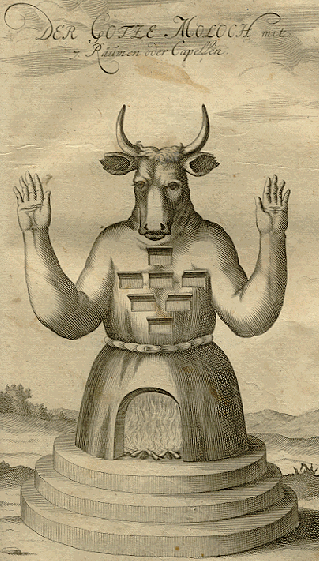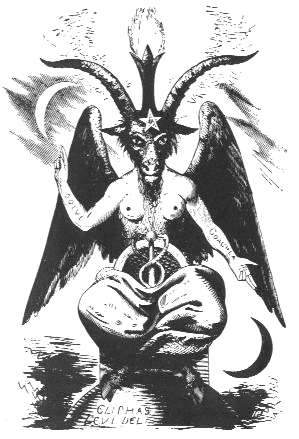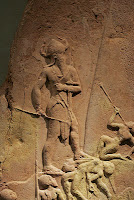The Black Mass...
The Black Mass is an invention of the Inquisition who were set up specifically to destroy the Knights Templar under the pretext of rooting out heresy.
Heresy was the Arian heresy- a philosophical debate about the true nature of Jesus. It had been decided at the Council of Nicaea (AD 325) that God, Jesus and the Holy Ghost (three in one) is like water, steam and ice- the same thing but different.
It was and perhaps still is (?) heretical to say that Jesus is Divine in his own right.
Those guilty of the Arian heresy say that God, Jesus and The Holy Ghost are too different to be the same thing and were persecuted by Theodosius 1, the same Theodosius that banned the worship of 'pagan' gods.
A thousand years latter, the populace could easily be forgiven for failing to get upset enough by this mistake, fine philosophical points about religion often require tedious explanations. Therefore other charges were required to destroy the Knights Templar; accusations of horrific crimes that no right minded individual could over look.
Thus the fantasy of the Black Mass was born.
The Templars were accused of spitting on and trampling the cross, and worshipping the Devil in the form of a black cat., and of prostrating themselves before an idol. The name of this idol was Baphomet, apparently it was composed of stuffed human heads.
The Templars were 'the poor knights of Christ', soldiers who followed Constantine's lead and conquered 'in the sign of the cross', but during their one hundred and fifty year history they gained from their enemy- the Muslims- skills and knowledge which would latter enrich European life, making Europe a more civilized society.
As a section of the population the Templars were different from the beginning, neither priest nor soldier, a combination of the two: warrior monks. Eventually their difference from the ordinary people worked against them. People were made- it was after all an orchestrated campaign led by King Philip IV of France to destroy an oligarchy- to distrust the Templars. The false accusations stuck because after a century of war the Templars had learned to respect their enemy, not least because they were united in faith.
Accusations of worshiping Baphomet was clearly a mispronunciation of Mohamed. Neither Christian or Muslim worships idols, but heathens (who ever they are) do. The message remains; the Templars are heretics. It is unlikely that many if any Templars became Muslim, but not impossible. The accusation was an intensification of the original heresy charge, repackaged in a way people could understand and fear; the name Baphomet sounds alien to European ears, and in the topsy turvy mirror world of satanic panic Baphomet could well be the name of a demon.
In 1312 the crime of worshipping Baphomet, plus numerous other false charges succeeded in bringing about the destruction of the Knights Templar, who were arrested, tortured into confessing to the imaginary crimes, and then burnt at the stake.
Their considerable wealth was seized by the state.
Now given credence by the executions The Black Mass- the worship of a strange idol- remained in the popular imagination as an authentic danger. One hundred years after the Templars had been burned at the stake Baron Gilles de Rais, was accused of conducting Black Masses in the cellar of his castle. The accusation claimed that he kidnapped, tortured, and murdered more than 140 children as sacrifices.
He was executed in 1440.
Why did he do it?
It was said that he did it in order to gain riches and power.
Did he do it?
No one knows...but he endured three days of torture.
By the 19th century Satanic panic was over, but the subject remained a source of fascination.
As to what one should do to perform a Black Mass, this account of The mass of Saint-Secaire (performed to curse someone to death) was written in 1843:
What if you don't have any toads, would a recording do?
Though the Inquisition were instrumental in creating a belief in The Black Mass, there are antecedents. The description of the Roman Bacchanalia as described by Livy:
The witch Erictho brings a corpse back to life to tell the future.
Where lay a corpse upon the naked earth
On ravening birds and beasts of prey the hag
Kept watch, nor marred by knife or hand her spoil,
Till on his victim seized some nightly wolf; (36)
Then dragged the morsel from his thirsty fangs;
Nor fears she murder, if her rites demand
Blood from the living, or some banquet fell
Requires the panting entrail. Pregnant wombs
Yield to her knife the infant to be placed
On flaming altars: and whene'er she needs
660 Some fierce undaunted ghost, he fails not her
Who has all deaths in use. Her hand has chased
From smiling cheeks the rosy bloom of life;
And with sinister hand from dying youth
Has shorn the fatal lock: and holding oft
In foul embraces some departed friend
Severed the head, and through the ghastly lips,
Held by her own apart, some impious tale
Dark with mysterious horror hath conveyed
Down to the Stygian shades.
It has long been known that the fear witchcraft inspires is more dangerous than the reality. The potency of this fear (rather than a desire to deal with any spirit or god) is what draws some groups of people to borrow its symbols and structures.
Most often the users do not believe that the symbols have any intrinsic power and conclude that it is legitimate to write of witches sacrificing babies and of singing toads and to make up anything shocking for the purposes of selling their books or papers.
Another section likewise know the symbols to be worldly artifacts with no connection to other worlds or beings, but use the fear these images inspire, to empower, or protect their work- The Steganographia (written c.1499) by Trithemius is one of those books. Ostensibly it is a book about withcraft, but a closer inspection shows it to be a work of cryptography: the practice and study of techniques for secure communication in the presence of third parties.
Trithemius wrote of cryptography as a...
The last executions for witchcraft in England had taken place in 1682, when Temperance Lloyd, Mary Trembles, and Susanna Edwards were executed at Exeter. Jane Wenham was among the last subjects of a typical witch trial in England in 1712, but was pardoned after her conviction and set free. Other people were executed after her, but the passion for persecuting witches was soon to be over.
As the state-level paranoia created by king James 1 subsided, the devil became a less serious matter until it became nothing but a symbol, waiting for someone to write a new narrative. In the early 19th century, Eliphas Levi (a friend of the man 'who created Vril- Bulwar-Lytton) , took the word: Baphomet and linked it to images in paintings by Goya's image of a sabbat, and Herodotus.
Translation from Herodotus by Wallis Budge:
In this painting Goya depicts mothers offering children to a goat-like animal. The image is reminiscent of the biblical accounts of offerings to Moloch.
Meaning the people offering their children to a monster out of animal cravings and stupidity...
Goya did not believe in monsters
Nevertheless Eliphas Levi picked up the image and describes the goat of the sabbot as The Goat of Mendes in Dogme et Rituel de la Haute Magie1855.
In 1919 Magick (Book 4), Alistair Crowley describes Baphomet as a divine androgyne and "the hieroglyph of arcane perfection":
In 1921 Margaret Murray in The Witch-Cult in Western Europe wrote that the devil was said to appear as "a great Black Goat with a Candle between his Horns".
So when people blog about Illuminati symbols in pop videos
Nothing new here folks, move on!
Heresy was the Arian heresy- a philosophical debate about the true nature of Jesus. It had been decided at the Council of Nicaea (AD 325) that God, Jesus and the Holy Ghost (three in one) is like water, steam and ice- the same thing but different.
It was and perhaps still is (?) heretical to say that Jesus is Divine in his own right.
Those guilty of the Arian heresy say that God, Jesus and The Holy Ghost are too different to be the same thing and were persecuted by Theodosius 1, the same Theodosius that banned the worship of 'pagan' gods.
A thousand years latter, the populace could easily be forgiven for failing to get upset enough by this mistake, fine philosophical points about religion often require tedious explanations. Therefore other charges were required to destroy the Knights Templar; accusations of horrific crimes that no right minded individual could over look.
Thus the fantasy of the Black Mass was born.
The Templars were accused of spitting on and trampling the cross, and worshipping the Devil in the form of a black cat., and of prostrating themselves before an idol. The name of this idol was Baphomet, apparently it was composed of stuffed human heads.
The Templars were 'the poor knights of Christ', soldiers who followed Constantine's lead and conquered 'in the sign of the cross', but during their one hundred and fifty year history they gained from their enemy- the Muslims- skills and knowledge which would latter enrich European life, making Europe a more civilized society.
As a section of the population the Templars were different from the beginning, neither priest nor soldier, a combination of the two: warrior monks. Eventually their difference from the ordinary people worked against them. People were made- it was after all an orchestrated campaign led by King Philip IV of France to destroy an oligarchy- to distrust the Templars. The false accusations stuck because after a century of war the Templars had learned to respect their enemy, not least because they were united in faith.
Accusations of worshiping Baphomet was clearly a mispronunciation of Mohamed. Neither Christian or Muslim worships idols, but heathens (who ever they are) do. The message remains; the Templars are heretics. It is unlikely that many if any Templars became Muslim, but not impossible. The accusation was an intensification of the original heresy charge, repackaged in a way people could understand and fear; the name Baphomet sounds alien to European ears, and in the topsy turvy mirror world of satanic panic Baphomet could well be the name of a demon.
In 1312 the crime of worshipping Baphomet, plus numerous other false charges succeeded in bringing about the destruction of the Knights Templar, who were arrested, tortured into confessing to the imaginary crimes, and then burnt at the stake.
Their considerable wealth was seized by the state.
Now given credence by the executions The Black Mass- the worship of a strange idol- remained in the popular imagination as an authentic danger. One hundred years after the Templars had been burned at the stake Baron Gilles de Rais, was accused of conducting Black Masses in the cellar of his castle. The accusation claimed that he kidnapped, tortured, and murdered more than 140 children as sacrifices.
He was executed in 1440.
Why did he do it?
It was said that he did it in order to gain riches and power.
Did he do it?
No one knows...but he endured three days of torture.
By the 19th century Satanic panic was over, but the subject remained a source of fascination.
As to what one should do to perform a Black Mass, this account of The mass of Saint-Secaire (performed to curse someone to death) was written in 1843:
The Mass of Saint Sécaire can only be said in a church where it is forbidden to congregate, because it is half-ruined, or because things were done there which no Christian should do. From these churches, the horned owls, the screech owls and the bats make their paradises. Gypsies lodge there. Under the altar, there are a bevy of singing toads.
The bad priest brings with him his mistress, to serve as his clerk. He must be alone in the church with this sow, and to have enjoyed a good supper. At the first stroke of eleven o'clock, he begins the mass, reading the whole thing backwards from the end, finishing at midnight exactly. The host is black, and has three points. The bad priest does not consecrate wine. He drinks the water of a well into which a child, who died unbaptized, has been thrown. The sign of the cross is always made on the ground, and with the left foot.Singing toads is a new one...I find myself asking, are the toads essential?
What if you don't have any toads, would a recording do?
Though the Inquisition were instrumental in creating a belief in The Black Mass, there are antecedents. The description of the Roman Bacchanalia as described by Livy:
There was no crime, no deed of shame, wanting. More uncleanness was committed by men with men than with women. Whoever would not submit to defilement, or shrank from violating others, was sacrificed as a victim. To regard nothing as impious or criminal was the sum total of their religion. The men, as though seized with madness and with frenzied distortions of their bodies, shrieked out prophecies; the matrons, dressed as Bacchae, their hair disheveled, rushed down to the Tiber River with burning torches, plunged them into the water, and drew them out again, the flame undiminished because they were made of sulfur mixed with lime. Men were fastened to a machine and hurried off to hidden caves, and they were said to have been taken away by the gods. These were the men who refused to join their conspiracy or take part in their crimes or submit to their pollution.
And latter this most famous description of a witch from Lucan in book 6 of his Pharsalia (A.D 61-65).
The witch Erictho brings a corpse back to life to tell the future.
Where lay a corpse upon the naked earth
On ravening birds and beasts of prey the hag
Kept watch, nor marred by knife or hand her spoil,
Till on his victim seized some nightly wolf; (36)
Then dragged the morsel from his thirsty fangs;
Nor fears she murder, if her rites demand
Blood from the living, or some banquet fell
Requires the panting entrail. Pregnant wombs
Yield to her knife the infant to be placed
On flaming altars: and whene'er she needs
660 Some fierce undaunted ghost, he fails not her
Who has all deaths in use. Her hand has chased
From smiling cheeks the rosy bloom of life;
And with sinister hand from dying youth
Has shorn the fatal lock: and holding oft
In foul embraces some departed friend
Severed the head, and through the ghastly lips,
Held by her own apart, some impious tale
Dark with mysterious horror hath conveyed
Down to the Stygian shades.
It has long been known that the fear witchcraft inspires is more dangerous than the reality. The potency of this fear (rather than a desire to deal with any spirit or god) is what draws some groups of people to borrow its symbols and structures.
Most often the users do not believe that the symbols have any intrinsic power and conclude that it is legitimate to write of witches sacrificing babies and of singing toads and to make up anything shocking for the purposes of selling their books or papers.
Another section likewise know the symbols to be worldly artifacts with no connection to other worlds or beings, but use the fear these images inspire, to empower, or protect their work- The Steganographia (written c.1499) by Trithemius is one of those books. Ostensibly it is a book about withcraft, but a closer inspection shows it to be a work of cryptography: the practice and study of techniques for secure communication in the presence of third parties.
Trithemius wrote of cryptography as a...
"...secular consequent of the ability of a soul specially empowered by God to reach, by magical means, from earth to Heaven"Cryptography, rather like the internet, is pretty close to magic.
The last executions for witchcraft in England had taken place in 1682, when Temperance Lloyd, Mary Trembles, and Susanna Edwards were executed at Exeter. Jane Wenham was among the last subjects of a typical witch trial in England in 1712, but was pardoned after her conviction and set free. Other people were executed after her, but the passion for persecuting witches was soon to be over.
As the state-level paranoia created by king James 1 subsided, the devil became a less serious matter until it became nothing but a symbol, waiting for someone to write a new narrative. In the early 19th century, Eliphas Levi (a friend of the man 'who created Vril- Bulwar-Lytton) , took the word: Baphomet and linked it to images in paintings by Goya's image of a sabbat, and Herodotus.
Translation from Herodotus by Wallis Budge:
At several places in the Delta, e.g. Hermopolis, Lycopolis, and Mendes, the god Pan and a goat were worshipped; Strabo, quoting (xvii. 1, 19) Pindar, says that in these places goats had intercourse with women, and Herodotus (ii. 46) instances a case which was said to have taken place in the open day. The Mendisians, according to this last writer, paid reverence to all goats, and more to the males than to the females, and particularly to one he-goat, on the death of which public mourning is observed throughout the whole Mendesian district; they call both Pan and the goat Mendes, and both were worshipped as gods of generation and fecundity. Diodorus (i. 88) compares the cult of the goat of Mendes with that of Priapus, and groups the god with the Pans and the Satyrs. The goat referred to by all these writers is the famous Mendean Ram, or Ram of Mendes, the cult of which was, according to Manetho, established by Kakau, the king of the IInd dynasty.[49]
In this painting Goya depicts mothers offering children to a goat-like animal. The image is reminiscent of the biblical accounts of offerings to Moloch.
 |
| An 18th-century German illustration of Moloch ("Der Götze Moloch" i.e. Moloch, the false god). |
Meaning the people offering their children to a monster out of animal cravings and stupidity...
Goya did not believe in monsters
| Goya: Nightmares are creatures of the imagination. |
 |
| Goya's depictions of witchcraft mocked what he saw as medieval fears exploited for political gain. |
Nevertheless Eliphas Levi picked up the image and describes the goat of the sabbot as The Goat of Mendes in Dogme et Rituel de la Haute Magie1855.
In 1919 Magick (Book 4), Alistair Crowley describes Baphomet as a divine androgyne and "the hieroglyph of arcane perfection":
The Devil does not exist. It is a false name invented by the Black Brothers to imply a Unity in their ignorant muddle of dispersions. A devil who had unity would be a God... 'The Devil' is, historically, the God of any people that one personally dislikes... This serpent, SATAN, is not the enemy of Man, but He who made Gods of our race, knowing Good and Evil; He bade 'Know Thyself!' and taught Initiation. He is 'The Devil' of the Book of Thoth, and His emblem is BAPHOMET, the Androgyne who is the hieroglyph of arcane perfection... He is therefore Life, and Love. But moreover his letter is ayin, the Eye, so that he is Light; and his Zodiacal image is Capricornus, that leaping goat whose attribute is LibertyThe image of the satanic great goat does not go away.
In 1921 Margaret Murray in The Witch-Cult in Western Europe wrote that the devil was said to appear as "a great Black Goat with a Candle between his Horns".
So when people blog about Illuminati symbols in pop videos
Nothing new here folks, move on!




